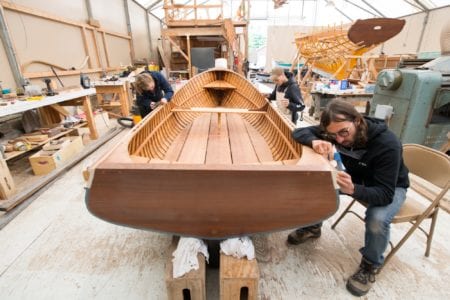Boat building is the construction of boats. It involves many factors such as hull, propulsion, navigation, safety and mechanical systems. In addition, the design of the boat is also important.
Fiberglass Reinforced Plastic (GRP)
Fiberglass Reinforced Plastic (GRP) is a composite material that is commonly used in the boatbuilding industry. It has several advantages over traditional materials. These include high strength-to-weight ratio, excellent impact resistance, corrosion resistance, and light weight. GRP is commonly used for hulls and decks, and can be molded in many shapes.
The fibers are woven together in a fabric like structure. The resulting material is flexible and durable. FRP has good mechanical properties, including a tensile strength.
FRP is made from glass fibers and a polymer matrix. Typically, the polymer matrix is epoxy or polyester. This combination provides the durability, elasticity, and toughness necessary for a GRP product.
Glass reinforced plastic is also known as fibreglass and can be used in numerous applications. Automotive manufacturers, boat builders, and wind turbine manufacturers utilize the material.
Steel
Steel is a common material used in the construction of boats. The material is known for its durability and resistance to corrosion. Boat builders use it for the hull, deck, rails, and fittings.
There are a few different metals used in building a boat. The best option will depend on your specific needs and budget.
Aluminum is an excellent choice for lighter weight boats. Stainless steel is also popular. However, there are some downsides to these materials. Some alloys, such as aluminum, have better corrosion resistance than others.
Titanium is another metal that may be used in a boat. It has good corrosion resistance and can be welded. This is particularly useful when the vessel will be in salt water. Several Russian submarines are constructed with titanium.
Monel is another alloy that can be used in the construction of a boat. It is extremely ductile and has a very high nickel content. Unlike copper, it is not prone to rust. In addition, Monel is relatively easy to weld.
Stitch-and-Glue method
The Stitch-and-Glue method of boat building has gained a lot of popularity. This is because it allows builders to use high quality marine plywood for their projects. It also saves time, as most construction methods require lots of tools and labor.
However, it is not the only method out there. Many other methods involve complex lofting and other specialized tooling. While this may produce a beautiful vessel, it is not always practical. Moreover, many of these methods do not yield the same results as the stitch and glue method.
For example, in the Stitch-and-Glue method, there is no need for molds. The hull of a boat is actually shaped by the planks themselves.
Another important feature of the Stitch-and-Glue method is that it requires less structure than other methods. Instead of using complicated and expensive tools, the Stitch-and-Glue method relies on epoxy fillers, fiberglass tape, and other inexpensive materials.
Reinforcing for high-load areas of the hull
In the world of naval architecture, reinforcing is usually used to enhance structural strength. Reinforcing materials may include carbon fiber, epoxy, fiberglass, carbon fiber cloth, steel, stainless steel, titanium, and aluminum. The types of reinforcing material used are dependent on the specific application and the hull’s weight and performance requirements.
The best and most expensive material for reinforcing is carbon fiber. Carbon fiber has a stiffer modulus of elasticity than E-glass and is much less susceptible to brittleness and stretchiness. It’s a little difficult to produce, though, as it requires plastic feedstock and temperatures of at least 3,000oC to make it work.
Another option for reinforcing the hull is sandwich structures. These systems involve a core of fiberglass or foam surrounded by a thin layer of epoxy or resin. Although they are heavier, sandwich structures allow for a smoother hull surface and better thermal insulation.
OECD’s Council Working Party on Shipbuilding (WP6)
The OECD’s Council Working Party on Shipbuilding (WP6) is an important international forum for discussing issues of shipbuilding policy. It provides a platform for peer dialogue, promotes policy transparency, and shares best practices. Several key challenges are facing the industry.
Shipbuilding is a highly cyclical sector. In recent years, the number of new orders for shipyards has dropped dramatically. As a result, many investors are adopting a wait-and-see attitude before ordering next generation ships. However, the shipping industry is expected to grow significantly over the next 15 years. This will put the economic viability of the industry under pressure in some regions.
Maritime transport is one of the key arteries of global trade. Today, 90% of traded goods are transported by oceans. Shipping is also one of the largest sources of GHG emissions. The International Maritime Organization has adopted a strategy for reducing GHG emissions from shipping by 50% by 2050.



